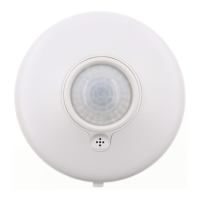PART NO. FEATURES
WORSID1-N-N
standard lens, PIR, 24Vac,
1-pole
WORXID1-N-N
extended lens, PIR, 24Vac,
1-pole
WORSID2-DPR-L
standard lens, PIR, 24Vac,
2-pole, dimming, photo,
relay, low temp.
WORXID2-DPR-L
extended lens, PIR, 24Vac,
2-pole, dimming, photo,
relay, low temp.
WORBID2-DPR-L
high-bay lens, PIR, 24Vac,
2-pole, dimming, photo,
relay, low temp.
• Commercial grade components for long term reliability
• Straightforward wiring for quick installation
• Factory congured for the most common applications
• DIP switches and dials for advanced functionality
• Options:
Operation
Diversa 24Vac (low voltage) sensors are powered by 24Vac from either the Diversa Series Power Pack (WP-PP20-***)
or a 24Vac transformer. When in operation, the sensor will detect initial motion using PIR; once motion is detected,
the sensor and Power Pack (or connected diode pulse relays) contacts will close. Motion through Passive Infrared
(PIR) is used to maintain the occupied condition as long as occupants remain within coverage pattern of Sensor.
Wiring Instructions
Wiring to a Power Pack
Black
White
Orange
Sensor
Link
WP-PP20-D
Override / Multi-Level Switching
Black
White
Black
White
Red
Red
Orange
Sw
Sw
(2-pole sensor requires 2-pole Power Pack)
The WOR Series Low Voltage sensors are equipped with #22AWG Leads. Use appropriate sized wire nuts to
connect the wires to the incoming load terminations.
Standard, Extended, High-Bay Lens
Dimming, Photo Sensor, Isolated Relay
Low Temperature/High Humidity
•
•
DIMENSIONS/MOUNTING inches (mm)
SPECIFICATIONS
•
3 0 ° Tilt
4.17”
(106)
0.88”
(2 2 )
DIPs and Dials
under cover
plate
Wire
Mounting
ring
Ceiling tile
2.0”
(52)
Power
• 24Vac
± 25%
• Class 2 low voltage source
• 60Hz
• Use #18AWG wire
Outputs
• Diode Pulse: Each output is capable of driving up to four Diode
Pulse relays
• 0-10V Dimming: Connections are polarity-sensitive - up to 25mA
• Isolated Relay: SPDT Form C contact rated for 1A at 30Vdc
Power Consumption
• 9.5mA Standard
• 14.0mA with Auxiliary Relay
Approvals
• FCC
Unit attaches to mounting ring with
screws or it can be mounted into an
octogan box.
Environment
• Indoors, stationary, non-vibrating, non-corrosive atmosphere and
• Ambient Operating Temperature: 32°F to 104°F (0°C to 40°C)
• Storage Temperature: -14°F to 140°F (-25°C to 60°C)
Octagon Box
Conduit
• The WOR sensor will t an octagon
box. It is very important that conduits
be attached at opposite ends of the
box.
• Use a 2 1/8 ” or more, deep box.
If the box is less, use the spacer ring.
non-condensing humidity
sinking
Sensor Location Guidelines
To optimize the performance of Diversa Sensors, please review the coverage pattern, range, and model to
match with the application. Room dynamics will change when people and furniture are occupying the space.
In some rooms, after move in, some sensors may require adjustments.
• Ensure that the sensor is at least 30 inches away from air handlers/registers and not pointed directly at
windows
• Check that you are installing the right product (check the product model number) as per the drawings
Sensor Location Guidelines for “P” models
• Place outside the direct cone of light from xtures
• Between 3 to 12 feet from windows
• As close as possible to the xture being controlled
• Above the least illuminated space in the work area
• Away from lighting that is not being controlled by the sensor
Installation
Standard Lens (S)
• Locate the sensor near the entrance door wall to prevent it from viewing out into the hallway.
• The lens can tilt, allowing the sensor to be pointed toward the area in front of the entrance door.
• Positioning the sensor in this manner ensures that an occupant moves across the longest detection beam
Typical Enclosed Oce
Side View
14 ft
7 ft
0 ft
7 ft
14 ft
9 ft
0 ft
14 ’ 12 ’ 10 ’ 6’ 3’ 0’ 3’ 10 ’6’ 12 ’ 14 ’
Top V iew
Extended Lens for Larger Rooms (X)
• Place the sensor near the center of the room ceiling. Locate it so the approximate distance of 27ft in
• Tilt the lens to aim the detection zone to the bottom of the door.
• Positioning the sensor in this manner ensures that the beam does not reach outside the room without
• Optimal usage is to detect large motions such as walking.
• Designed for a mounting height of 7-15ft.
Typical Classroom
27ft
27ft
C
Side View
27 ft
14 ft
0 ft
14 ft
27 ft
9 ft
0 ft
27 ’
16 ’ 9’ 3’
0’
3’
9’
16 ’
27 ’
Top V iew
or in dead center of room.
reducing sensitivity.
• Designed for a mounting height of 7-15 ft
upon entrance, utilizing the sensor's maximum PIR range.
High Bay Lens for High Ceiling Applications (B)
• For 15 to 40 foot ceilings
• Position sensor based on ceiling height, beam pattern
and coveage requirements
40 ft
18 ft
0 ft
18 ft
40 ft
40 ft
20 ft
10 ft
0 ft
Side V iew
40 ’
30 ’ 20 ’ 10 ’
0’
10 ’
20 ’
30 ’
40 ’
Top V iew
ON = Test Mode
DIP Switches
Time Delay Dial
Ranges from 30s to 30 min.
Full turn Clockwise for Auto Time
Full turn Counterclockwise for Test Mode
Light Level Dial
Used to determine light
level for Photo Functions
Manual Override Button
Grey (-)
Violet (+)
WhiteBlue
Red
Red/White
Orange
Auto Time LED
Test Mode LED
(Shown with cover
plate removed)
Yellow/White
Yellow
Yellow/Black
NC
COM
NO
(Only models with Isolated Relay)
0-10V Dimming
(Only models with Dimming)
Sensor Link
Secondary Output Pole
Primary Output Pole
Return 24Vac
•
Line Voltage Passive Infrared (PIR) Occupancy / Vacancy Sensor
Installation Guide
Diversa Occupancy & Vacancy Sensors - Recessed Ceiling, Passive Infrared (PIR), 24Vac
www.douglaslightingcontrols.com
Diversa by Douglas Lighting Controls
14040200-C

